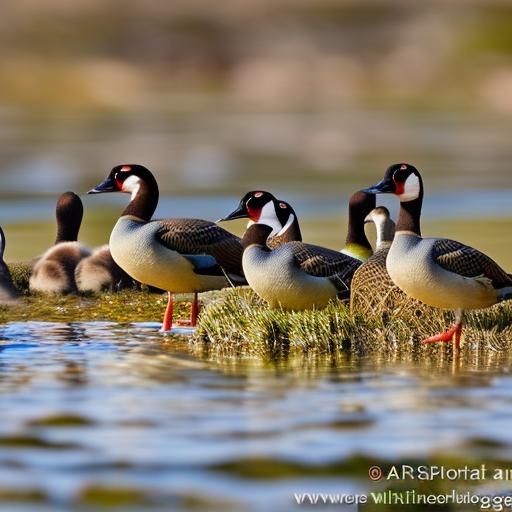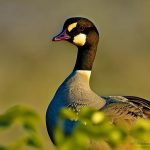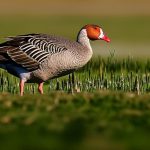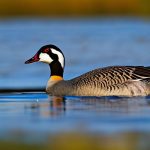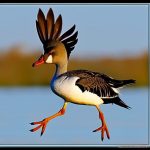Canadian geese nesting on private property can be a nuisance for homeowners and property owners. These birds are known for their aggressive behavior and can cause damage to lawns, gardens, and other areas where they choose to nest. Finding humane solutions to prevent nesting is important to protect both the property and the geese themselves.
Key Takeaways
- Canadian geese are territorial and protective of their nesting sites.
- Nesting sites can be identified by looking for areas with tall grass and water nearby.
- Removing nesting materials can discourage geese from returning to the same site.
- Physical barriers such as fences or netting can prevent geese from accessing nesting sites.
- Sound deterrents such as loud noises or predator calls can scare geese away.
Understanding the Behavior of Canadian Geese
Canadian geese choose certain nesting sites based on a variety of factors. They prefer areas near water, such as ponds, lakes, or rivers, where they can easily access food and water for themselves and their young. They also look for areas with tall grass or vegetation that can provide cover and protection. Understanding these preferences can help in identifying potential nesting sites and implementing prevention strategies.
Canadian geese are monogamous and typically mate for life. They begin nesting in early spring, with the female laying an average of 5-7 eggs. The male and female take turns incubating the eggs for about a month until they hatch. During this time, they can become territorial and aggressive towards anyone who comes near their nest. Once the eggs hatch, the goslings are able to walk, swim, and feed themselves within a day or two.
Identifying Potential Nesting Sites
To prevent Canadian geese from nesting on private property, it is important to identify potential nesting sites. These may include areas near bodies of water, such as ponds or lakes, as well as areas with tall grass or vegetation. Regular property inspections can help in identifying these potential sites before the geese have a chance to nest.
It is also important to be aware of any signs of nesting activity, such as the presence of nesting materials or droppings. Canadian geese build nests out of grass, leaves, and other materials, so removing these materials can help discourage them from nesting on the property.
Removing Nesting Materials
Removing nesting materials is an important step in preventing Canadian geese from nesting on private property. By removing these materials, you are making the area less attractive to the geese and reducing the chances of them choosing to nest there.
When removing nesting materials, it is important to do so safely and without harming the geese. It is recommended to wear gloves and use a rake or other tool to remove the materials. Be sure to dispose of them properly, as geese may be attracted to the scent of their own nesting materials and may attempt to rebuild their nest if they find them nearby.
Installing Physical Barriers
Physical barriers can be an effective way to prevent Canadian geese from nesting on private property. There are several types of physical barriers that can be used, including fences, netting, and spikes.
Fences can be used to create a physical barrier between the geese and the property. They should be at least 3-4 feet high and have small openings or mesh to prevent the geese from getting through. Netting can also be used to cover areas where the geese may try to nest, such as rooftops or balconies.
Spikes can be installed on ledges or other areas where the geese may try to land or nest. These spikes make it uncomfortable for the geese and discourage them from staying in that area.
Using Sound Deterrents

Sound deterrents can be an effective way to prevent Canadian geese from nesting on private property. These deterrents work by emitting loud noises or sounds that are unpleasant to the geese, causing them to leave the area.
There are several types of sound deterrents that can be used, including sonic devices, propane cannons, and predator calls. Sonic devices emit loud noises or distress calls that mimic the sounds of predators or other threats. Propane cannons create loud explosions or bangs at regular intervals, which can startle and scare away the geese. Predator calls, such as those of hawks or eagles, can also be effective in deterring geese.
Employing Visual Deterrents
Visual deterrents can be used to prevent Canadian geese from nesting on private property. These deterrents work by creating visual disturbances or illusions that make the area less attractive to the geese.
There are several types of visual deterrents that can be used, including scarecrows, reflective tape, and decoys. Scarecrows can be placed in areas where the geese may try to nest, creating a visual disturbance that discourages them from staying. Reflective tape can be hung in areas where the geese may try to land or nest, creating a visual deterrent. Decoys, such as those of predators or other birds, can also be effective in deterring geese.
Applying Repellents
Repellents can be used to prevent Canadian geese from nesting on private property. These repellents work by creating an unpleasant taste or smell that the geese find unappealing.
There are several types of repellents that can be used, including chemical repellents and natural repellents. Chemical repellents can be sprayed on areas where the geese may try to nest, creating a taste or smell that deters them. Natural repellents, such as garlic or hot pepper sprays, can also be effective in deterring geese.
Implementing Habitat Modification
Habitat modification can be an effective way to prevent Canadian geese from nesting on private property. By modifying the property to make it less attractive to the geese, you can discourage them from choosing to nest there.
Some tips for modifying the property include removing tall grass or vegetation near bodies of water, as this provides cover and protection for the geese. You can also create barriers or fences around areas where the geese may try to nest, such as gardens or lawns. Additionally, removing or reducing food sources, such as grass clippings or bird feeders, can help discourage the geese from staying on the property.
Seeking Professional Assistance
In some cases, it may be necessary to seek professional assistance to prevent Canadian geese from nesting on private property. There are several types of professionals who can assist with this, including wildlife control experts and pest management professionals.
Wildlife control experts are trained in dealing with nuisance wildlife, including Canadian geese. They can assess the property and recommend the best prevention methods based on the specific situation. Pest management professionals can also provide assistance in preventing geese from nesting on private property.
Maintaining a Consistent Prevention Strategy
Maintaining a consistent prevention strategy is important to avoid future nesting by Canadian geese. Once you have implemented prevention methods, it is important to continue monitoring the property and making any necessary adjustments.
Regular property inspections can help in identifying any potential nesting sites or signs of nesting activity. By addressing these issues promptly, you can prevent the geese from establishing a nest on the property.
Preventing Canadian geese from nesting on private property is important to protect both the property and the geese themselves. By understanding their behavior and preferences, identifying potential nesting sites, and implementing prevention methods such as removing nesting materials, installing physical barriers, using sound and visual deterrents, applying repellents, implementing habitat modification, seeking professional assistance when necessary, and maintaining a consistent prevention strategy, homeowners and property owners can effectively prevent Canadian geese from nesting on their property. Taking action to prevent nesting can help create a more peaceful and enjoyable environment for everyone involved.
If you’re looking for ways to keep Canadian geese from nesting, you might also be interested in learning how to convert a shed into a chicken coop. Creating a safe and comfortable space for your chickens can help deter geese from taking up residence on your property. Check out this helpful article on poultrywizard.com to discover the steps and tips for transforming a shed into a functional chicken coop. By implementing these strategies, you can not only protect your chickens but also discourage unwanted geese from nesting in your vicinity.
FAQs
What are Canadian geese?
Canadian geese are a species of waterfowl that are native to North America. They are known for their distinctive black heads and necks, white cheeks, and brown bodies.
Why do Canadian geese nest in unwanted areas?
Canadian geese are known to nest in areas that provide them with easy access to food and water. They are also attracted to areas that are quiet and secluded, which makes them more vulnerable to predators.
What are the risks of having Canadian geese nesting in unwanted areas?
Canadian geese can cause damage to property, create health hazards, and pose a threat to human safety. They are known to be aggressive when protecting their nests and can attack humans who get too close.
What are some effective ways to keep Canadian geese from nesting in unwanted areas?
Some effective ways to keep Canadian geese from nesting in unwanted areas include using visual deterrents, such as scarecrows or reflective tape, installing physical barriers, such as fences or netting, and using sound deterrents, such as loud noises or predator calls.
Is it legal to remove Canadian geese nests?
It is illegal to remove Canadian geese nests without a permit from the U.S. Fish and Wildlife Service. However, there are some exceptions to this rule, such as when the nest poses a threat to human safety or property.
Meet Walter, the feathered-friend fanatic of Florida! Nestled in the sunshine state, Walter struts through life with his feathered companions, clucking his way to happiness. With a coop that’s fancier than a five-star hotel, he’s the Don Juan of the chicken world. When he’s not teaching his hens to do the cha-cha, you’ll find him in a heated debate with his prized rooster, Sir Clucks-a-Lot. Walter’s poultry passion is no yolk; he’s the sunny-side-up guy you never knew you needed in your flock of friends!

